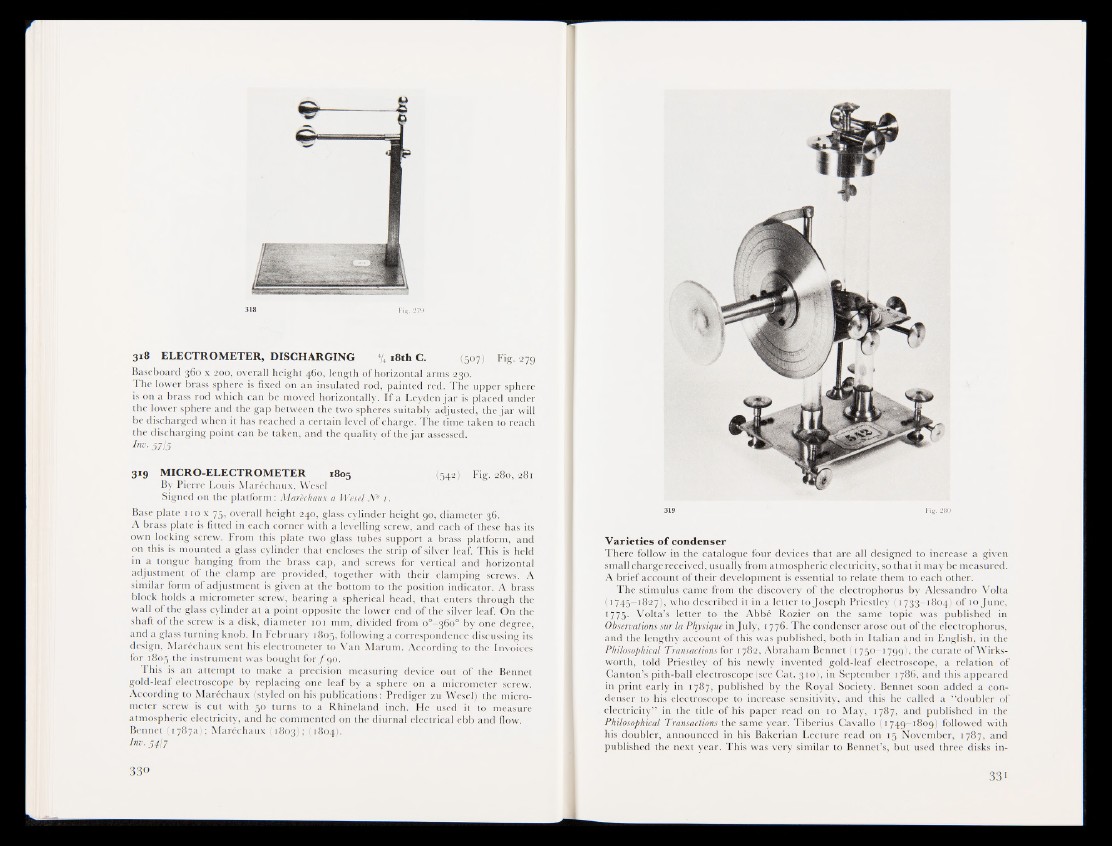
3*8 ELECTROMETER, DISCHARGING % 18th C. gsoçflj Fig. 279
Baseboard 360 x 200, overall height 460, length of horizontal arms 230.
The lower brass sphere is fixed on an insulated rod, painted red. The upper sphere
is on a brass rod which can be moved horizontally. If a Leyden jar is placed under
the lower sphere and the gap between the two spheres suitably adjusted, the jar will
be discharged when it has reached a certain level of charge. The time taken to reach
the discharging point can be taken, and the quality of the jar
Inv- 5715
319 MICRO-ELECTROMETER 1805 (542H Fig. 280, 281
By Pierre Louis Maréchaux, Wesel
Signed on the platform : Maréchaux a Wesel N° r.
Base plate 110 x 75, overall height 240, glass cylinder height 90, diameter 36.
A brass plate is fitted in each corner with a levelling screw, and each of these has its
own locking screw. From this plate two glass tubes support a brass platform, and
on this is mounted a glass cylinder that encloses the strip of silver leaf. This is held
in a tongue hanging from the brass cap, and screws for vertical and horizontal
adjustment of the clamp are provided, together with their clamping screws. A
similar form of adjustment is given at the bottom to the position indicator. A brass
block holds a micrometer screw, bearing a spherical head, that enters through the
wall of the glass cylinder at a point opposite the lower end of the silver leaf. On the
shaft of the screw is a disk, diameter 101 mm, divided from op—360° by one degree,
and a glass turning knob. In February 1805, following a correspondence discussing its
design, Maréchaux sent his electrometer to Van Marum. According to the Invoices
for 1805 the instrument was bought for ƒ 90.
This is an attempt to make a precision measuring device out of the Bennet
gold-leaf electroscope by replacing one leaf by a sphere on a micrometer screw.
According to Maréchaux (styled on his publications: Prediger zu Wesel) the micrometer
screw is cut with 50 turns to a Rhineland inch. He used it to measure
atmospheric electricity, and he commented on the diurnal electrical ebb and flow.
Bennet (1787a); Maréchaux (1803) ; (1804).
H 54l 7
319 tig. 280
V a rie tie s o f co n d en ser
There follow in the catalogue four devices that are all designed to increase a given
small charge received, usually from atmospheric electricity, so that it may be measured.
A brief account of their development is essential to relate them to each other.
The stimulus came from the discovery of the electrophorus by Alessandro Volta
(1745—1827), who described it in a letter to Joseph Priestley (1733—1804) of 10 June,
1775- Volta’s letter to the Abbé Rozier on the same topic was published in
Observations sur la Physique in July, 1776. The condenser arose out of the electrophorus,
and the lengthy account of this was published, both in Italian and in English, in the
Philosophical Transactions for 1782, Abraham Bennet ( 1750—1799)', the curate of Wirks-
worth, told Priestley of his newly invented gold-leaf electroscope, a relation of
Canton’s pith-ball electroscope (see Cat. 310), in September 1786, and this appeared
in print early in 1787, published by the Royal Society. Bennet soon added a condenser
to his electroscope to increase sensitivity, and this he called a “doubler of
electricity” in the title of his paper read on 10 May, 1787, and published in the
Philosophical Transactions the same year. Tiberius Cavallo (1749—1809) followed with
his doubler, announced in his Bakerian Lecture read on 15 November, 1787, and
published the next year. This was very similar to Bennet’s, but used three disks in